Quang Binh has bold characteristics of the North Central region,a convergence of many ethnic groups,creating a rich and diverse cultural picture. This land is not only famous for its long-standing traditional craft villages but also has many cultural similarities with other regions in the country. Let's explore 9 long-standing traditional craft villages in Quang Binh in the article below with 63Stravel.
Explore 9 traditional craft villages in Quang Binh
Tourists visiting traditional craft villages in Quang Binh not only learn about people's lives and explore traditional handicraft products,but also have the opportunity to immerse themselves in rich cultural life. They can participate in many unique festivals and spiritual events,and experience the unique cultural features of the people here.
Canh Duong fish sauce craft village
Canh Duong fishing village - a romantic coastal land located next to the Roon River,famous for traditional craft villages such as fishing,making fish sauce and dried seafood. Visitors coming here not only learn about the craft village and the belief in worshiping the sea god,but also have the opportunity to enjoy unique lullabies.
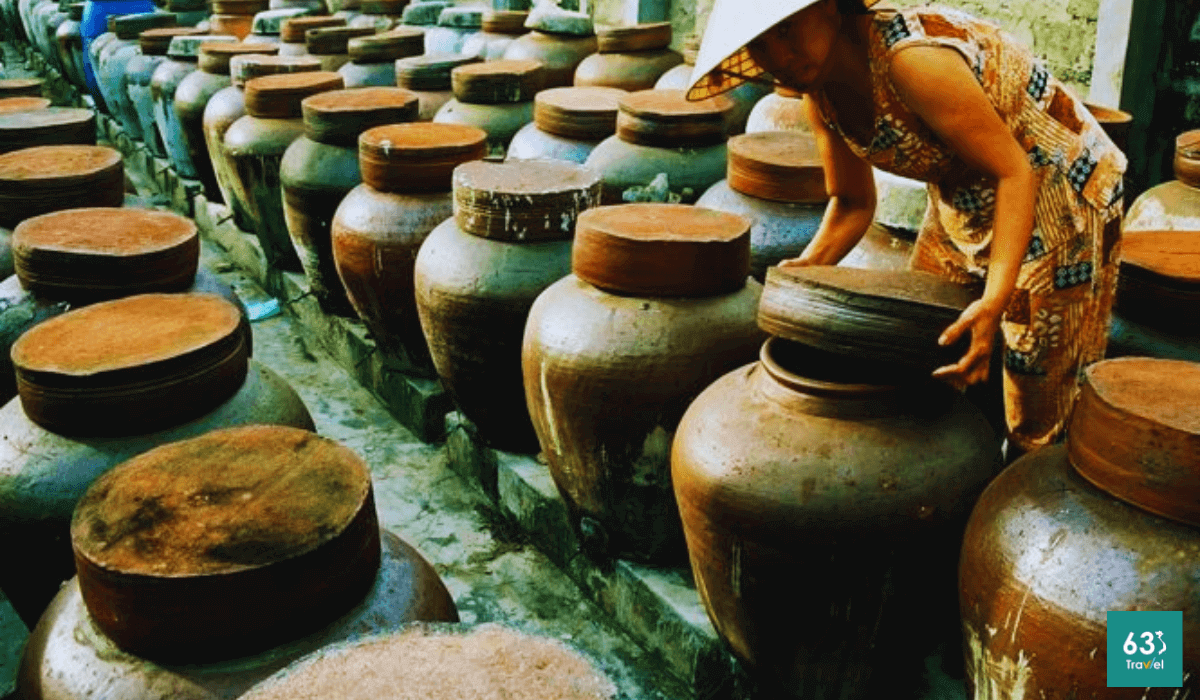
Traditional fish sauce making profession in Canh Duong commune
Among them,the long-standing traditional profession of making fish sauce is known to many people. People here use many types of fish such as anchovies,scads,herring... to prepare fish sauce completely according to traditional methods,without any preservatives. Canh Duong fish sauce is the crystallization of experience,diligence and hard work of local people.
Coming to Canh Duong,visitors not only admire the rich village landscape but also have the opportunity to experience the lives of the people,participating in traditional occupations such as making fish sauce,making basket boats and carpentry. The rich cultural and historical values of this fishing village will certainly leave a deep impression in the hearts of every visitor.
Bao Ninh Fish Sauce Craft Village
Bao Ninh fish sauce,with a history dating back hundreds of years,is a traditional profession of residents of Bao Ninh commune,only 6km from Dong Hoi city. Tourists coming to Dong Hoi can easily visit this craft village to learn about the fish sauce production process. Bao Ninh fish sauce is famous for its salty,marine flavor and is made from fresh mu scad,through the process of salting for 8 to 12 months in wooden barrels. After that,the fish sauce is filtered,bottled and preserved.
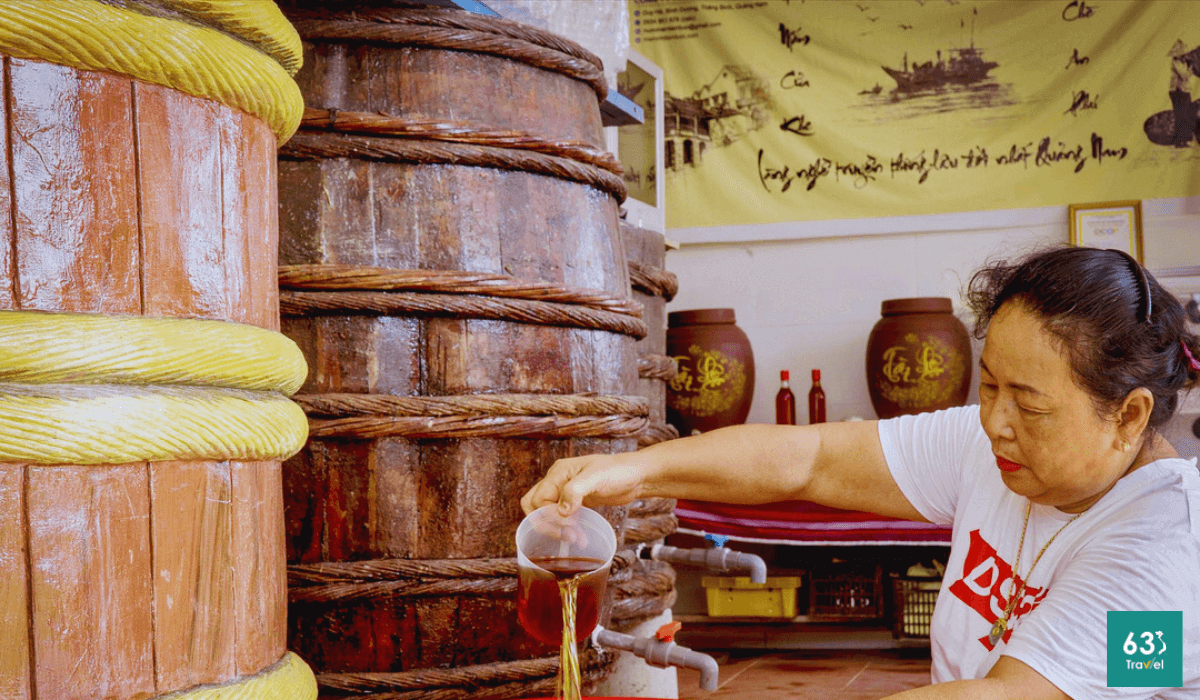
Bao Ninh fish sauce - Rich flavor of Quang Binh
However,fish sauce production in Bao Ninh has experienced many ups and downs,especially the marine environmental pollution incident in 2016,causing many establishments to close. Although the sea has recovered,consumer sentiment is still affected. Only in the last two years has Bao Ninh fish sauce gradually regained its position in the market,although it still faces many challenges in production standards.
Currently,Bao Ninh commune only has about 100 small fish sauce producing households,with famous establishments such as Thuong Dinh and Long Tam continuing to maintain their names. Bao Ninh fish sauce is not only a unique culinary product but also a symbol of the diligence and patience of the people of Quang Binh.
An Xa sedge mat craft village
An Xa village - the hometown of General Vo Nguyen Giap,located in Loc Thuy commune,Le Thuy district,Quang Binh province,has long been famous for its traditional sedge mat making. Appearing more than 600 years ago,mat weaving has become an indispensable part of the lives of people here. During leisure time,this profession helps generate additional income and brings prosperity to the village.
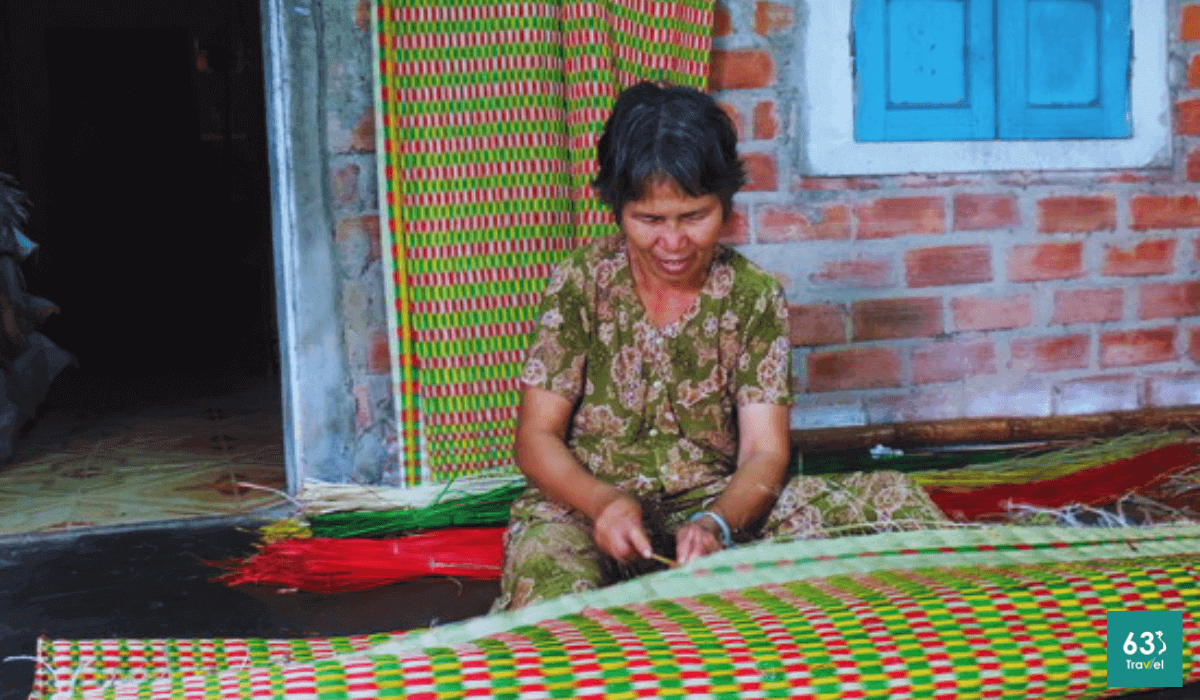
Visit An Xa sedge mat weaving village - Le Thuy,Quang Binh
Currently,An Xa has about 80 households still maintaining the profession,using traditional manual methods to produce sedge mats. The process of making mats requires many meticulous and elaborate steps,from growing sedge,harvesting,sorting,splitting,drying to weaving mats. Under the skillful hands of the people,rustic but sophisticated mats were born,becoming a typical product of the village.
Although many traditional craft villages are gradually disappearing,the profession of making sedge mats in An Xa is still preserved and developed through generations. People here not only love their profession but are also conscious of preserving the cultural values left by their ancestors. When visiting An Xa village,visitors will admire the beauty of the artisans' labor through each stage of production,from choosing sedge,dyeing to weaving the finished mat.
>> Read more: Discover the Top 10+ incredibly beautiful tourist attractions in Quang Binh
Quy Hau conical hat village
Quy Hau village in the low-lying land of Le Thuy,Quang Binh is famous for the craft of making conical hats,which has developed strongly since the early 20th century. Quy Hau conical hats,although not slender and light,have their own beauty: certainly,sharp,elegant and durable,with a lifespan twice that of hats in many other places.
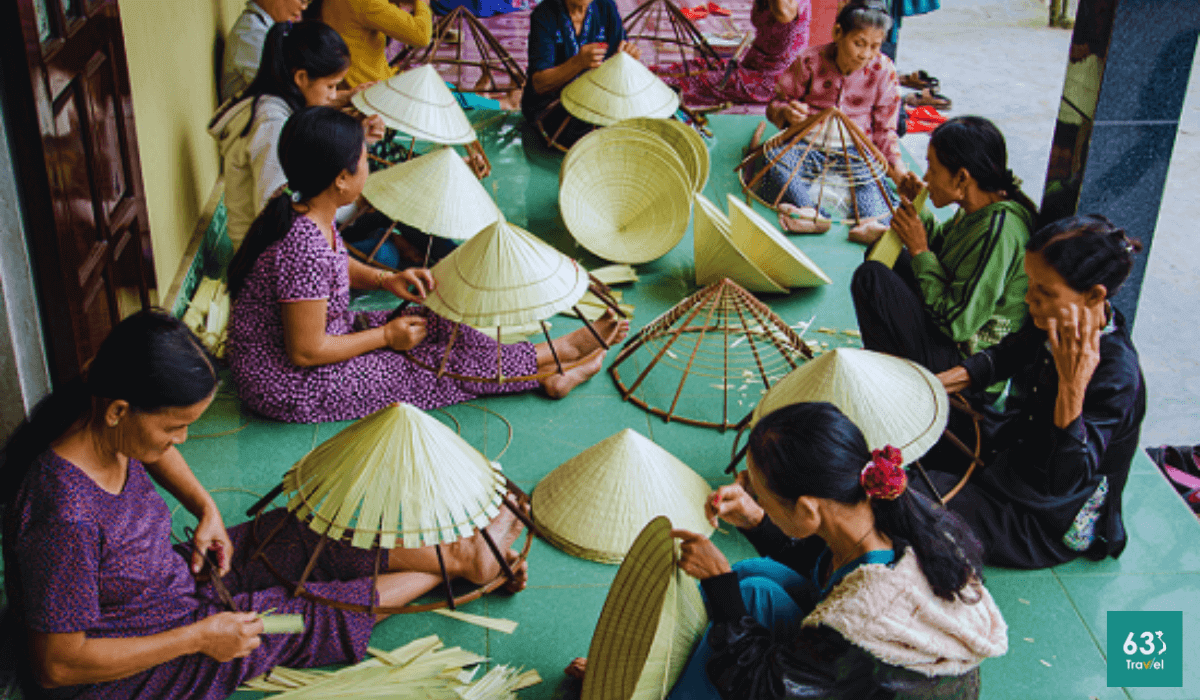
Visit the hundred-year-old Quy Hau conical hat craft village in Le Thuy - Quang Binh
To make a beautiful,light and durable hat,the craftsman needs skill and passion,with each step requiring high expertise. Quy Hau conical hats,despite many ups and downs,still maintain their reputation thanks to their durability and beauty.
Today,with the development of tourism,hats are no longer simple but are decorated with drawings and embroidery depicting images,culture and people of Quang Binh. This contributes to enriching the traditional beauty of this land.
Tho Ngoa hat village
Tho Ngoa,in Quang Thuan ward,Ba Don town,is a land rich in culture and history,with nearly 40% of households participating in the traditional conical hat making profession. Although it is a side job,hat making here is very developed,bringing a stable source of income for people.
The Crouching Leaf Conical Hat is not only a familiar item but also a symbol of attachment to women,always being improved in design and quality to enhance beauty and charm. The profession of making hats has been associated with the lives of Tho Ngoa people for hundreds of years,becoming a unique feature of this land. Although the hat making ward is no longer as busy as before,the traditional profession still maintains and develops,becoming the pride of the people here.
Agarwood village in Bo Trach
The traditional incense making village in Quyet Thang village,Quang Binh has existed for hundreds of years,becoming an indispensable part of people's lives here. As soon as you entered the village,a gentle scent wafted everywhere. The deeper you went,the stronger the scent became. The image of people holding bamboo sticks and putting them in foam boxes,sprinkling them with incense powder and shaking them well has become familiar.
The profession of making incense in Quyet Thang has been passed down from generation to generation,most families have been doing this profession for the third generation. All year round,people also do other agricultural and fishery work,but every time Tet approaches,they put everything aside to focus on making incense,not only to earn extra income but also to keep the fire alive in the traditional craft village. system.
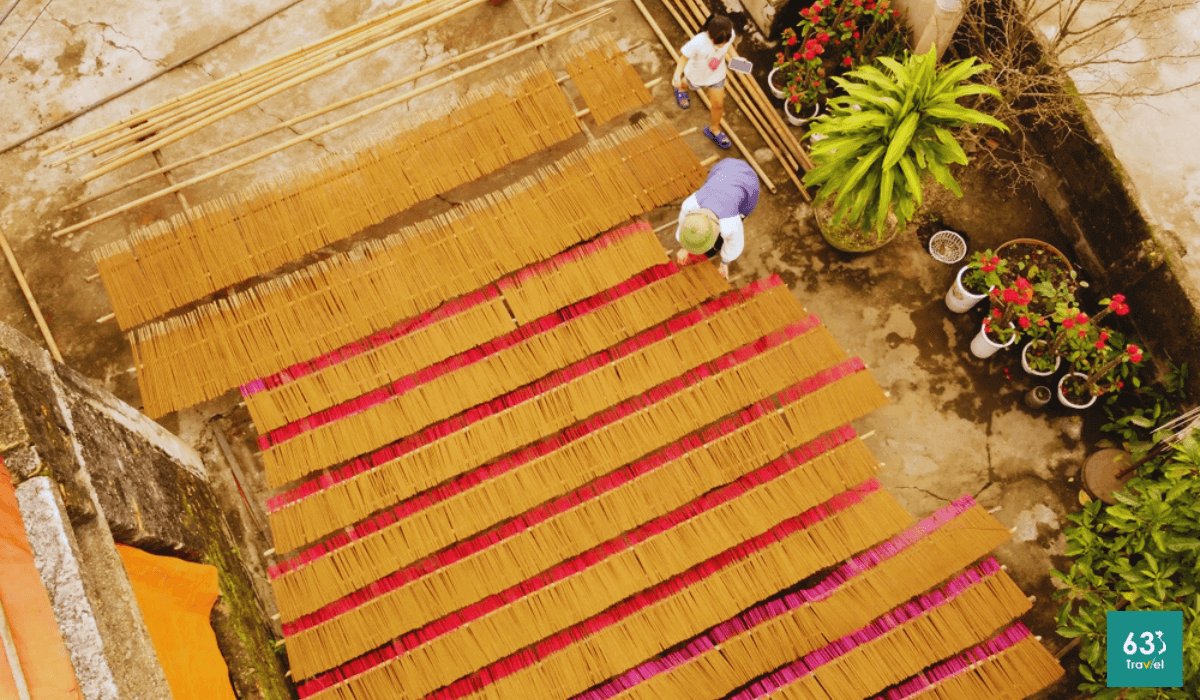
Traditional agarwood craft village in Quang Binh
The process of making handmade incense is very complicated,starting with preparing ingredients right at the beginning of the year. People go to the forest to find leaves and roots of the incense tree,an important plant in the production of incense,then buy bamboo and split it into pieces for use throughout the year. Making incense requires health and patience. People have to sit from morning to night to soak bamboo sticks in adhesive,sprinkle incense powder and shake well to make the powder stick to the bamboo sticks.
Once completed,the incense is dried everywhere,from empty yards to fences and roadside sidewalks. The incense is then tied into bundles of 100 - 150 trees and sold for 150,000 - 200,000 VND/bundle. This job brings a stable source of income,helping the people of Quyet Thang village have a full and happy Tet.
Mai Hong blacksmithing and casting village
Mai Hong craft village,located in village 8,Dong Trach commune,Bo Trach district,is a place that has long been famous for traditional blacksmithing. Since the mid-20th century,the blacksmithing profession here has developed in the form of cooperative production and business.

The 100-year-old forging village keeps the flame of the profession in Quang Binh
Nowadays,Mai Hong people have actively applied technology to production,from equipping machinery such as steel rolling machines,grinding machines,punching machines,hammers,cutting machines... This has helped the craft village transform from agricultural production to diversify products according to market demand. At the same time,improving product quality and accuracy also enhances labor efficiency,reduces costs and increases revenue and profits.
Tho Don bamboo and rattan weaving village
Tho Don village has long been famous for its bamboo and rattan weaving craft. Appearing more than 400 years ago,the weaving profession in Tho Don has gone through many ups and downs,but still stands firm and develops.
With rudimentary but quintessential hands,Tho Don people every day sculpt bamboo and bamboo sticks to create extremely useful products to serve life. Initially,the craft village mainly produced bamboo baskets,baskets,etc. used in agriculture.
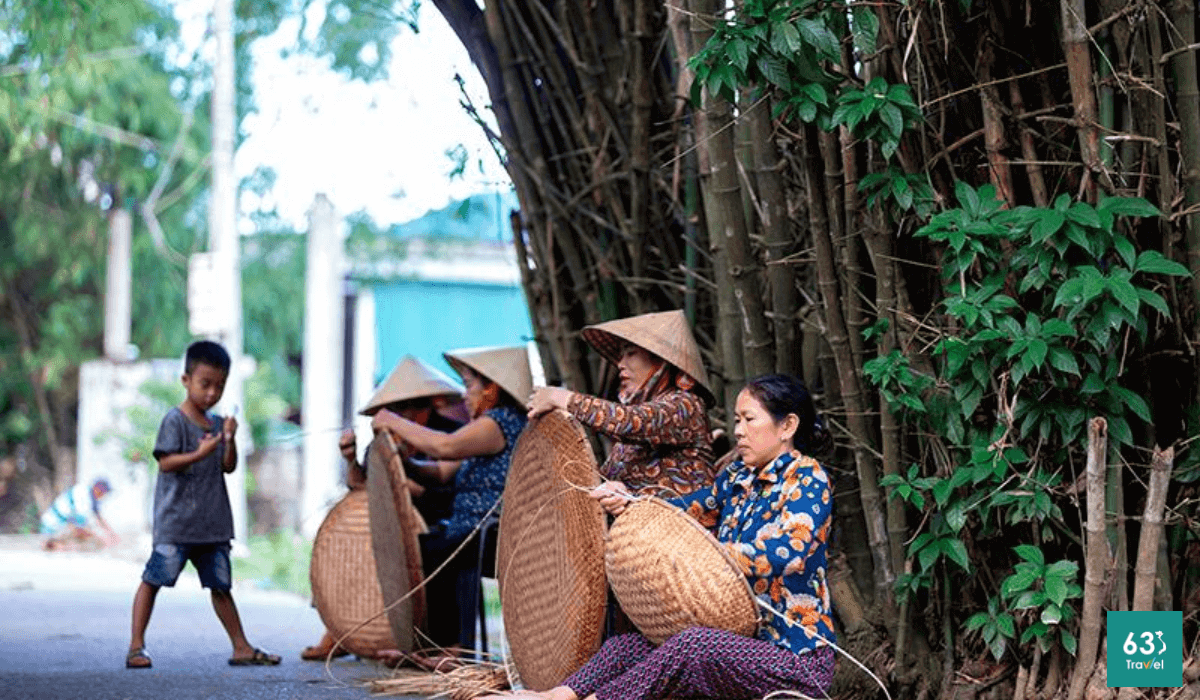
'Keeping the fire' of the 400-year-old wicker craft village in Tho Don
However,with the development of the market,Tho Don has cleverly adapted and expanded the production of fishing supplies. Thanks to elite craftsmanship,products from Tho Don are not only popular locally but are also trusted by markets outside the province.
Tho Don Village is a clear testament to the sustainability and creativity in the weaving profession,continuing to grow and develop over many generations,contributing to enriching folk culture and improving socio-economic life. of locality.
>> Search for more: TOP 10+ historical sites in Quang Binh famous for their longevity over the years
Tan An rice paper village
Tan An rice paper craft village has more than 100 years of history making rice paper,and is one of the destinations not to be missed when exploring Quang Binh. Initially,Tan An rice paper village also produced rice paper,vermicelli and banh chung,but after a long time,they focused mainly on rice paper production.
The village's outstanding specialty is sesame rice paper,made meticulously and diligently from rice flour by local people. With high quality ingredients and no chemicals used,Tan An rice paper has a unique flavor,is soft and supple,suitable for rolling with shrimp,meat,vegetables and enjoying with sweet and sour fish sauce or seasoning sauce. .
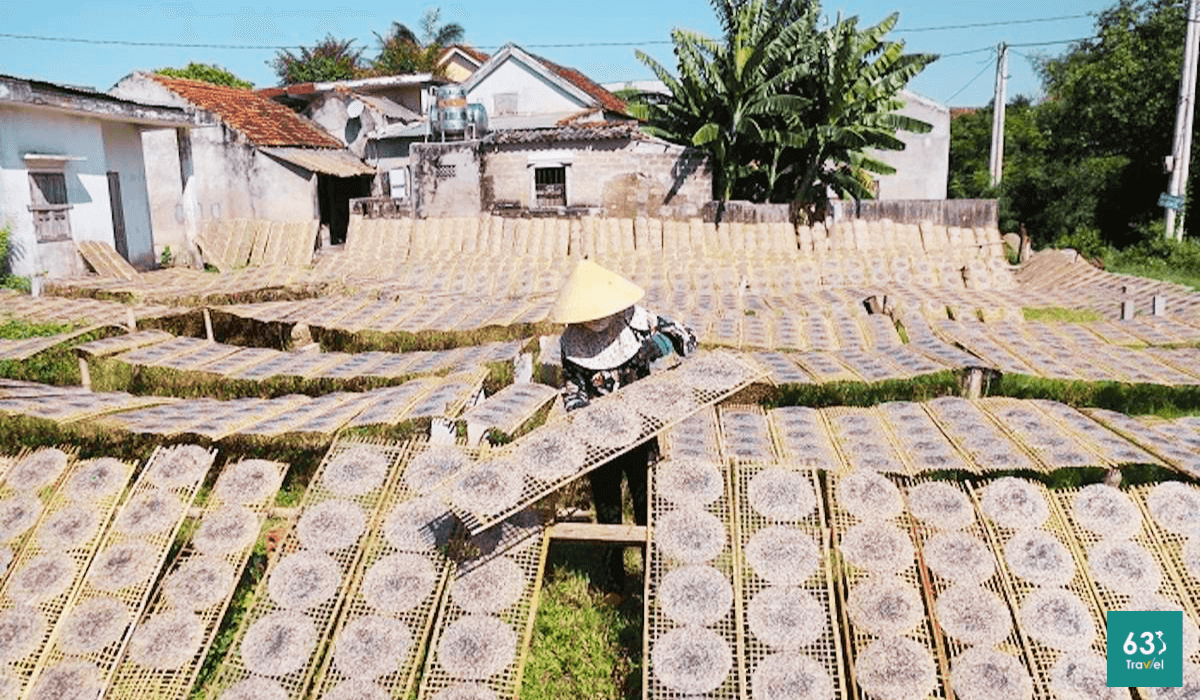
Visit Tan An rice paper craft village - Quang Binh rice paper specialty
Products from traditional craft villages in Quang Binh are not only beautiful in design but also outstanding in high quality. They have a strong local cultural identity and are always loved by tourists.
If you have the opportunity to visit Quang Binh,take the time to explore and experience traditional craft villages,where you can understand more about the local culture and people. Don't forget to bring back typical products of the craft village as gifts for family and friends,which are meaningful gifts from this land.
Above is a summary of 9 traditional craft villages in Quang Binh that have existed for hundreds of years. If you have the opportunity to visit this land of Quang Binh,please visit the craft villages and experience it!
Quang Tri 8491 view
Update day : 23/06/2024
Coming to Bao Ninh, you will be immersed in an extremely open, wild and quiet natural space. You will only hear the whispering waves and the whirring wind in your ears without being crowded. like other key beaches. In addition, around are green coconut palms swaying in the wind and scenes of simple activities of people in Bao Ninh fishing village. You should come here in the early morning to catch the brilliant sunrise on the sea, when the first rays of the day begin to appear in the distance, the illuminated sea surface becomes beautifully iridescent. Or you can also walk barefoot on the beach in the late afternoon, when the sunset closes the day and the fishing boats return after a day at sea. Bao Ninh Beach is right next to Nhat Le beach, so if you want to visit Nhat Le, you just need to go through Nhat Le bridge to get there. In addition, standing on Nhat Le bridge and looking down at the water and sea surface of Bao Ninh is extremely beautiful and peaceful. After the morning watching the sunrise on the sea, you can also move to Bao Ninh square located right on the beach with extremely attractive and attractive entertainment activities. If you are lucky enough to come during the festival season, you can also witness the fishing and harvest festival that the fishing village people set up. Some attractions around Bao Ninh beach that you can visit are the ancient Citadel relics, Ca Ong temple or Mother Suot monument, Quang Binh Quan, General Vo Nguyen Giap's tomb or especially if there is one. Maybe Son Doong cave... Historical sites around this area will be an opportunity for you to gain more historical knowledge as well as social understanding, so you can learn more deeply about the war years. The arduous struggle of our army and people.
Quang Tri
March to November
5921 lượt xem
Mooc Stream is located in Phong Nha Ke Bang National Park, about 60 km from Dong Hoi city. To get here you can follow the Ho Chi Minh Trail, the stream flows into the Con River towards the delta. At Khe Gat intersection, turn west and go about 5 km to Mooc stream. The stream is covered with vast green forests, the climate is cool, and the air humidity is high. Summer travel here is very suitable, you will feel like you are lost in a giant natural air conditioner. Mooc Stream in Quang Binh originates from a large lake about 80 - 90 square meters wide, downstream the stream flows into a large river. There are many rugged rocky beaches here, creating an interesting landscape. Along the stream, the shade of trees spread out into the middle of the stream like umbrellas above the water. Trees that grow well help retain water and humidity, making the air cool and fresh. Mooc Spring appears in the wild natural landscape of deep forest, tourists seem to be overwhelmed by the beautiful scene before their eyes. Each stream, tree branch and green grass is full of life, the tingling sound of nature blends with the sound of flowing water to create a lively harmony. On this S-shaped strip of land, there are places where people and nature can harmonize so closely. You can immerse yourself in the space of the mountains and forests to enjoy the feeling of relaxation, stretching all your senses to hear, to see, to feel the fragrance of life. Coming here, you can also participate in many entertainment activities, there are many thrilling games, requiring the player's flexibility and dexterity: Kayaking, hanging bridge, zipline... Sitting on a kayak, skillfully controlling the oar along the water flow to the fast-flowing sections, the player must brace themselves to keep the oar going through the strong current. The ticket price for kayaking at Nuoc Mooc spring is about 50,000 VND per session. Going on the suspension bridge is for those who are not afraid of heights. Take each step carefully on each wooden slat of the suspension bridge if you don't want to fall into the water. Not only are you careful, you also have to be very skillful to participate in this entertainment. Many rustic dishes are served here made from native ingredients: Stir-fried wild vegetables with garlic, grilled eel, grilled chicken, porridge soup. Sitting on thatched huts enjoying dishes brings a very new feeling. In the summer, Mooc stream truly becomes a wonderful ecological area, with cool spring water and fresh scenery. Going here with friends for a picnic on weekends or holidays will be a great idea, the wild nature will give you memorable photos. The tourist destination is quite new so everything seems "intact", seemingly separate from outside life. In addition, you can visit places near Mooc stream such as Chay river and Dark row. Dark Cave has deep underground streams flowing through creating air conditioning. Inside there are many multi-shaped stalactites and stalactites with almost no light, complete darkness. If you turn off the flashlight, it feels like everything is swallowed by darkness, the eyes are filled with suffocating blackness.
Quang Tri
March to August
5836 lượt xem
Famous as one of the world's largest natural wonders in Vietnam today, located in Quang Binh province and chosen by many tourists. This place not only contributes greatly to preserving nature, flora and fauna, but also creates an impressive tourist destination for tourists right from the first visit. Phong Nha Ke Bang National Park is located about 45 km from Dong Hoi city center. With a structure consisting of two main parts: Phong Nha cave and the majestic Ke Bang limestone mountain range many years old. Brings the feeling of being lost in a separate sky, both wild and imbued with the natural beauty of an attractive ecosystem. Located in Quang Binh province, a city in the Northern region, it has a tropical monsoon climate with two distinct dry and rainy seasons. To have a convenient trip to Phong Nha Ke Bang National Park, you should choose the time from April to August. At this time the weather is dry, little rain and beautiful sunshine, suitable for sightseeing and activities. interesting. As for the period from September to December, the weather is prone to rain and even storms. If you visit at this time, it will be quite disadvantageous to travel and cause many potential dangers. Besides, from January to March the high water season also causes disadvantages when visiting Phong Nha cave and other cave systems. Currently, choosing a hotel when visiting Phong Nha Ke Bang National Park is quite popular among tourists. Because this also affects the tourism process more or less. If you have questions about choosing a Quang Binh hotel, you can rest assured because this is currently a developed tourism province. When coming here, it is not too difficult to choose a hotel that suits the needs, interests and financial capabilities of visitors. To be more proactive about your time, you can choose to consult and book hotel rooms in advance at websites, or through the convenient Traveloka app. Referring to one of the attractions not to be missed when coming to Quang Binh national park, Phong Nha cave is known as "Thien Nam's first cave" with its majestic and wild beauty. After following the clear blue water, you will reach the cave entrance with a height of 10m, then proceed to explore the 8,000m long cave system, with 12 different large and small caves. Bringing unexpected experiences to visitors while visiting the national park. Through many changes, golden sand beaches, blue underground lakes and impressive stalactites have formed inside the cave. It all seems to create a vivid picture created by nature over hundreds of millions of years. To get in, you need to buy a ticket for about 120,000 VND/adult, free for children and rent a boat for about 550,000 VND/12-seat boat. Possessing an area of more than 40 hectares, the botanical garden is a diverse ecosystem and is also a conservation area not to be missed when visiting Phong Nha Ke Bang national park. Here, you can experience the process of Trekking to explore and check in to Thac Gia, Vang Anh Lake, and animal raising area. In addition, you can also visit the model exhibition house to see rare animals and plants. The ticket price to enter the botanical garden will be about 40,000 VND/adult and 20,000 VND/child. This promises to be an interesting and memorable experience for nature lovers who always want to discover the beauty and wonder of flora and fauna. Thien Duong Cave is known as the longest dry cave in Asia, with a total length of 31.4km, naturally formed in a limestone complex and surrounded by pristine, rich primeval forest. To reach the cave, you need to pass 524 wooden steps, then comfortably enjoy the cool atmosphere and the magical beauty of the impressive stalactites. Therefore, this place has become an indispensable tourist destination when coming to Phong Nha Ke Bang national park.
Quang Tri
From April to August
6297 lượt xem
When coming to Quang Binh, you must definitely visit Bai Da Nhay - located at the foot of Ly Hoa pass in Thanh Trach area, Bo Trach district, Quang Binh province. With a long coastline, fine golden sand and blue sea water, it creates a beautiful "background" with no dead corners, suitable for virtual living. The best time to go to Quang Binh is from the first months of the year until May (according to the solar calendar). June, July, and August are quite sunny and hot, while September, October, November, and December are rainy and cold seasons. You can rent a motorbike in Dong Hoi to go to Da Nhay beach, which is also quite ok. From Dong Hoi City, you run towards Dong Hoi Airport and then go straight about 25 kilometers to get there. When you arrive, park your car at a convenient restaurant to eat lunch. The first impression that appears when coming to Da Nhay Beach is that the beach is clean with little trash, the sea water is clear and blue, and the air is cool. You walk a bit to reach the rocky beach. Attached is a set of stairs to climb to the top. Stand from above and look down to see the panoramic view of Da Nhay Beach. Rest assured that in Da Nhay Beach, there are many shops and restaurants close to the beach, with very reasonable prices, so you can eat and drink to your heart's content, always with fresh seafood. After finishing eating, you can rest in the hammocks under the hut and enjoy the cool sea breeze, which is also not a bad idea.
Quang Tri
From January to December
5732 lượt xem
Located in Tho Son village, Quang Trach district, Quang Binh province and about 3km from National Highway 1A, Vung Chua - Yen Island is known as the resting place of the heroic general of the nation Vo Nguyen Giap. This area has an area of about 10 hectares and is located right at the foot of the majestic Ngang Pass. Vung Chua is a clear blue beach with long stretches of white sand and surrounded by a peaceful scene of endless green forests. Vung Chua faces the East Sea but is quite sheltered from the wind, so this place is said to be a land with a quite prime location. Yen Island is a small island about 1km from Vung Chua shore. If you go by boat, it will only take about 20 minutes to get here. Many people commented that Yen Island is like a screen emerging in the middle of the sea with the belief that this place will guard the land and sea, protecting human life. Vung Chua - Yen Island has now become a pilgrimage destination attracting many tourists to visit and burn incense to commemorate the heroic general every year. Local people have recounted that in the past this land was called Hon Nom based on the direction calculation. However, later a company brought the bird's nest here to raise it to exploit the bird's nest, so from here a lot of bird's nest came to live. The name Yen Island, Quang Binh, also came from there. So where does the name Vung Chua come from? According to local people, in the past there was a large pagoda in this area, but now through ups and downs of time, only traces of the pagoda's foundation remain, but the name Vung Chua comes from that. This area is also surrounded by three islands: Hon La, Hon Gio and Hon Nom, forming a three-legged triangle so it is quite airtight so ships often anchor when there is a storm. In addition to the tomb of General Vo Nguyen Giap, many people may still not know that on the island there is also an ancient tomb that has been passed down orally from people as the tomb of famous general Tran Dat, who had meritorious service in the Lam Son uprising against enemy from the North with Le Loi. After learning more about the history books left behind, we learned that the family of famous general Tran Dat was very famous in the area because there were many people who were awarded the title of marquis, duke or academician... However, the church they are currently in Thuan Bai village, Quang Thuan commune, Quang Trach district. So Quang Binh is honored to welcome two generals about 500 years apart to rest here. The grave of General Vo Nguyen Giap is located on the shore, at a 110m high point on Dragon Mountain, overlooking the sacred Yen Island, and the grave of famous General Tran Dat, who was instrumental in defeating the Northern invaders and saving the people, is also nearby. That area makes Vung Chua - Dao Yen more majestic.
Quang Tri
From January to December
6016 lượt xem
Trung Thuan war zone is located in the semi-mountainous area of Quang Luu and Quang Thach communes, Quang Trach district, about 5 km west of Ba Don town. Once an important revolutionary base for the army and people of Quang Trach during the resistance war against the French colonialists and American imperialists, Trung Thuan war zone has become a heroic historical testimony and the pride of every person. people around here. Trung Thuan War Zone is a national historical relic site in 1995. The war zone is located on the area of two communes, Quang Luu and Quang Thach. However, the main area still belongs to Quang Thach commune. The ancient Trung Thuan war zone was a valley surrounded by many high mountains and dense forests in a U shape. In the war zone, there was Chop Chai peak, nearly 1,000m above sea level, which became an ideal "observatory" for the soldiers. the whole region. In small hamlets of Trung Thuan such as Duong Khe, Ha hamlet, Xuan Vuong, Kim Thanh, Tam Da, Trung Chinh, Tien Mieu, Dinh Cu, Phu Luu, Van Tap... Archaeologists have discovered many Archaeological artifacts such as: Phu Luu bronze drums, Dong Son type I bronze drums, bronze fish hooks, bronze axes and traces of Lam Hamlet ruins. Trung Thuan during the Trinh - Nguyen conflict period was a large base of the Trinh army north of the Gianh River. Dai Don base (Trung Thuan) along with Roon station and Thuan Bai station were important strategic defense lines of the Trinh army. In the north of Gianh River, the remaining vestiges are Tau Voi well, Vong Bai island... During the Can Vuong period, Trung Thuan was the base of Le Truc's insurgent army in the Can Vuong movement against the French in Quang Binh. Trung Thuan is an important base in the entire Can Vuong base system such as Huong Son, Huong Khe (Ha Tinh), Quy Dat, Khe Ve..., the remaining vestiges are Bai Tap, Bach Thach, Linh Than, Fish pond, Grinding stone slot, Tien Mieu hamlet, Xuan Vuong hamlet. During the resistance war against the French colonialists, the Trung Thuan war zone was not only the place where the District Party Committee, the Administrative Committee and the headquarters of Quang Trach district worked, but also the place where they trained and prepared the uprising forces to seize power. power and additional forces to jointly defend Vo Xa to seize power in Dong Hoi town in August 1954. During the resistance war against America to save the country, Trung Thuan was the rear base of the B70 Corps of the Vietnamese People's Army. This is a transit point in the Ho Chi Minh road system to support human and material resources for the struggle to liberate the South and unify the country. Due to its important role, in 1968 and 1972, the Trung Thuan war zone was heavily bombarded by American aircraft. Local soldiers and people sacrificed a lot, however, with their stubborn will, that still did not shake the revolutionary spirit of the army and people here. With his important contribution, in 1971, Trung Thuan war zone was honored to welcome General Vo Nguyen Giap to visit and summarize the victory of Route 9-Southern Laos. Source: Quang Binh Newspaper
Quang Tri 6879 lượt xem
Doc Mieu military base is located in Gio Phong commune, Gio Linh district, Quang Tri province. This historical site is quite famous and is considered an "impregnable fortress" during the resistance war against the French colonialists and American imperialists. Located east of National Highway 1A, about 7km south of Hien Luong Bridge, Doc Mieu is a basalt hill located in a terrain area consisting of three zigzag slopes. This is also the defense line built by the US called Namara - the name of a general commanding the US - Puppet army, to prevent all reinforcements from the North and the Southern battlefield. Among them, Doc Mieu military base is the most important base in this line. Here, the enemy built a system of vaulted tunnels and mobile blockhouses made of concrete. Along with that is an artillery battle towards the north bank of the Ben Hai River, a control center to protect the fence, an armored patrol squad, and many American and puppet companies deployed. Surrounding the base are barbed wire fences with 12 layers of 3m high, on top is a fence with automatic mines, under the fence is a dense minefield hundreds of meters wide. In 1972, our army and people simultaneously opened fire, fired DKD grenades, A12 grenades, and rocket launchers, surrounding the Doc Mieu military base. After three consecutive days of attacks, the enemy had to flee on the night of March 31, 1972, leaving behind their posts, associates, and modern electronic fence system. Currently, our government built a victory monument to recognize the soldiers who fought heroically. At the foot are long, straight rubber hills, proof of the vibrant revival of life in this once-torn land. Doc Mieu military base relic has become a historical tourist attraction for tourists to visit every time they come to Quang Tri. This is not only a symbol of our nation's indomitable fighting spirit but also has profound educational significance for the country's future generations. Source: Quang Tri Newspaper
Quang Tri 6652 lượt xem
Truong Son Martyrs Cemetery is located on Ben Tat hill, next to National Highway 15, in Vinh Truong commune, Gio Linh district; about 38km northwest of the provincial center (Dong Ha town); about 20km northwest of National Highway 1A (in Gio Linh district town). After the day of national reunification, the Party Central Committee and the Ministry of National Defense approved the project to build the Truong Son martyrs cemetery in Quang Tri province as a place to commemorate and honor the beloved children of the heroic homeland. Bravely sacrificed his blood on the Truong Son roads for the cause of national liberation. Construction of the cemetery began on October 24, 1975 and was completed on April 10, 1977. The construction commander is the 559th Division Command with the participation of more than 40 main army units and local soldiers. There is also a group of workers specializing in engraving words on stone stele in Hoa Hai commune, Hoa Vang district, Quang Nam province. Truong Son Martyrs Cemetery is where 10,333 graves of martyrs gather; has a total area of 140,000m2; Of which, the grave area is 23,000m2, the monument area is 7,000m2, the green tree planting area is 60,000m2, the lake area is 35,000m2 and the paved road network within the cemetery grounds is 15,000m2. The grave plot is divided into 10 main areas. Truong Son Martyrs Cemetery is the eternal resting place of the soldiers who sacrificed their lives on the Ho Chi Minh Trail during the anti-American era to save the country. This is the most massive, largest-scale, highly artistic gratitude project, expressing the deep remembrance, gratitude and secret honor of the entire Party, the entire army and the entire people of our country. with our beloved children in all parts of the country who spared no blood for the cause of the struggle to liberate and unify the country. On the occasion of the 40th anniversary of the founding of the Truong Son army (May 19, 1959 - May 19, 1999), the Party and State decided to upgrade and renovate Truong Son cemetery including many items: Entrance gate to Truong Son cemetery, road system and surrounding wall, command post model, local symbols, statue clusters, drainage system, internal electricity, planting trees around the cemetery and houses celebration, Fatherland Radio recognized... Up to now all items of the project have basically been completed. Truong Son Martyrs Cemetery today is not only the resting place of heroic martyrs but also a place of worship, a shining symbol of revolutionary heroism, of the spirit and will to fight for independence. independence and the desire for peace of our people. Truong Son Martyrs Cemetery is not only a place for martyrs' families, Party and State delegations, and local governments to visit and perform gratitude work, but also a place of pilgrimage. of people all over the country and international friends following the noble moral tradition of the Vietnamese people: when drinking water, remember its source. Currently, Truong Son Martyrs Cemetery has 24 officers and employees who regularly take care of, repair and welcome martyrs' families and domestic and foreign delegations to visit. Source: Office of the People's Committee of Quang Tri Province
Quang Tri 6431 lượt xem
Vinh Moc Tunnels and Vinh Linh Tunnel Village System are magnificent underground military structures, born during the resistance war against the US to save the country. With the slogan "militarize the entire population, fortification of the entire region" Vinh Linh's army and people have dug trenches, with many functions: headquarters, logistics warehouses, schools, hospitals, living areas. of each family..., arranged throughout the residential areas, along the roads, along the fields, and on the coast, connected by a network of trenches instead of roads on the ground. From the end of 1965 to 1968 (according to incomplete statistics), the entire Vinh Linh district had 114 tunnels with a total length of more than 40km, a trench system of more than 2,000km and hundreds of other tunnels, which became "tunnel village" - appeared for the first time in the history of the Vietnam War, expressing the will to "not move one inch, not leave one inch" to stay and fight to protect the homeland and keep blood vessels open to the front line. Vinh Moc Tunnels and Vinh Linh tunnel village system are distributed throughout 15 communes and towns of Vinh Linh district, Quang Tri province, including: 1. Vinh Moc Tunnel (Vinh Thach). Belongs to Vinh Moc village and Son Ha village, Vinh Thach commune. Includes 13 doors (6 doors open to the hill, 7 doors open to the sea). Along both sides of the tunnel, there are small niches enough for 2 to 4 people. In the basement there is also a hall (capacity of 50 to 60 people), a place for meetings, watching movies, performing arts... and a number of other works such as: bulletin board, maternity home, 3 water wells, toilet, surgery station, infirmary, cooking kitchen (Hoang Cam kitchen). In addition to the underground tunnel and tunnel system, Vinh Moc Tunnels also has above ground works such as trenches, artillery emplacements, breakwaters, exhibition houses... 2. Hien Dung tunnel system (Vinh Hoa). Located in Hien Dung village, Vinh Hoa commune, including 2 tunnels: The tunnel of the People's Armed Police Command in Vinh Linh area is about 1,540m long, including 18 up and down doors and 15 ventilation wells. The People's Armed Police Information Tunnel in Vinh Linh area has 8 up and down doors and 10 ventilation wells. 3. Huong Nam tunnel system, Troong Mon - Cua Hang, Rooc village and Hai Quan tunnels (Vinh Kim). Including Huong Nam Tunnel: belongs to Huong Nam village, Vinh Kim commune. Troong Mon tunnel system: located close to the coast of Vinh Kim commune. Cua Hang Tunnel: The tunnel axis runs East - West, with 2 doors. Rooc village tunnel: belongs to Rooc village Naval Tunnels: These tunnels are located close to each other within a radius of 50m including: Naval Tunnel 1, Naval Tunnel 2, Naval Tunnel 3, Naval Tunnel 4. 4. Mui Si tunnel system, tunnel 61 (Cua Tung town). Including Mui Si Tunnel: located on the coastal road from Cua Tung to Vinh Moc Tunnel, in Thach Ban neighborhood, Cua Tung town. Tunnel 61: located on the road leading to Ben village, An Hoa 2 neighborhood, Cua Tung town. 5. Naval Tunnels (Vinh Nam). Located on a hill in Nam Cuong village, Vinh Nam commune. Vinh Moc Tunnels and the Vinh Linh underground village system are historical evidence of strength, indomitable spirit, the unyielding will to hold on to the land to defend the village, the unique creativity of the people's war, and a shining symbol of revolutionary heroism, greatly contributing to the victory of the resistance war against America to save our nation. With particularly typical values, the historical relics of Vinh Moc Tunnels and Vinh Linh Tunnel Village System (Vinh Linh district, Quang Tri province) have been ranked as special national relics. Source: Department of Cultural Heritage
Quang Tri 6391 lượt xem
General Secretary Le Duan's memorial area is located on the banks of Thach Han River, in Hau Kien village, Trieu Thanh commune, Trieu Phong district, Quang Tri province. The memorial relic area of General Secretary Le Duan was recognized as a national relic on October 29, 2010. Le Duan (1907 - 1986) was a son of Bich La Dong village, Trieu Dong commune, Trieu Phong district, Quang Tri province. Born and raised in a land with a rich patriotic tradition, Le Duan soon became enlightened about the revolution. In 1928, he joined the Vietnam Revolutionary Youth Association and became one of the first class members of the Communist Party of Vietnam. A life of vibrant revolutionary activities is closely linked to the history of revolutionary struggle as well as the cause of national liberation and building Socialism of the Party and country. During 26 years, as First Secretary and then General Secretary, no matter what the circumstances, comrade Le Duan always upheld the steadfast spirit of communists, especially those who contributed to it. Your great contribution to the revolutionary cause of national liberation, national reunification, and bringing the whole country forward to build socialism initiated and led by the Communist Party of Vietnam. Le Duan deserves to be an outstanding leader of the nation, a steadfast soldier of the international Communist and workers' movements and an outstanding son of his homeland Quang Tri. "Relics of General Secretary Le Duan's memorial area", is the common name for a complex of relics including: Comrade Le Duan's memorial house - the living place of comrade's family since moving from Bich La Dong to Hau Kien is now a place to worship two of his parents and comrades in his hometown, Hau Kien village; The memorial house is a place to hold ceremonies and visit visitors; The additional gallery is a place to display artifacts and photos related to comrade Le Duan's life and career. The memorial house of late General Secretary Le Duan is located on an area of 2,000 square meters. Formerly the house and garden of Le Hiep's father. The house is made of wood, quite spacious. Through two brutal wars, the house was burned many times, and after liberation, only the floor remained. In 1976, to show respect and gratitude for his great contributions to the Party and State, the Party Committee and people of Trieu Phong district joined hands to help rebuild his family's house on the ground. old. The house is structured in the form of an old bank, consisting of 3 rooms and 2 wings, with a back house (lower house) 4.5m wide, 9m long, thatched roof, bamboo walls, plastered with mud and wood. Inside the house, furniture such as beds, beds, tables, altar cabinets, etc. were restored. At the end of 1977, the thatched roof was damaged and the District People's Committee replaced it with moldy tiles. From 1978 - 1985, it continued to undergo many repairs and renovations, replacing bamboo walls with pressed wood. In 1995, the Quang Tri Provincial Museum restored the house based on the structure of the old house (four or two wings, with a back house) 10m wide, 12m long, each room 2.5m wide, each wing 1m wide. .5m with awning. In 2005, the planning, construction, restoration and embellishment of the memorial site of General Secretary Le Duan was completed, and a number of artifacts and documents previously displayed in the memorial house were transferred to display at the Exhibition House. additional. The memorial house is still used as a place to worship his parents and comrade Le Duan. The memorial relic area of General Secretary Le Duan is a historical relic commemorating typical famous people of Quang Tri province, linking the youth and years of revolutionary activities of the comrade in his hometown with the existence and developing the revolutionary struggle movement of the Party Committee and people of Quang Tri in the two resistance wars against French colonialism and American imperialism. Source: Quang Tri Provincial Museum and Monument Management Center
Quang Tri 6297 lượt xem


Download the Travelviet app to receive notifications about the latest travel news
